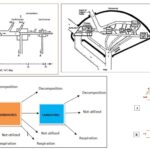Biochemistry 5 Views 1 Answers
Sourav PanLv 9April 18, 2025
what happens in the krebs cycle
what happens in the krebs cycle
Please login to save the post
Please login to submit an answer.
Sourav PanLv 9May 15, 2025
In the Krebs cycle, acetyl-CoA, derived from the breakdown of carbohydrates, fats, and proteins, combines with oxaloacetate to form citrate. This is followed by a sequence of eight enzymatic reactions that progressively oxidize citrate, releasing two molecules of CO₂, generating three molecules of NADH, one FADH₂, and one GTP (or ATP) per cycle turn. Several intermediates, such as α-ketoglutarate and succinyl-CoA, are formed and converted through oxidation, decarboxylation, and hydration reactions. The cycle concludes by regenerating oxaloacetate, enabling continuous operation as long as substrates and cofactors are available.
0
0 likes
- Share on Facebook
- Share on Twitter
- Share on LinkedIn
0 found this helpful out of 0 votes
Helpful: 0%
Helpful: 0%
Was this page helpful?




